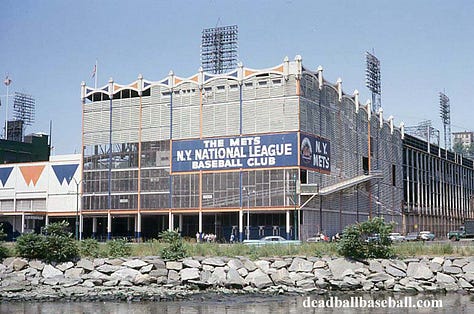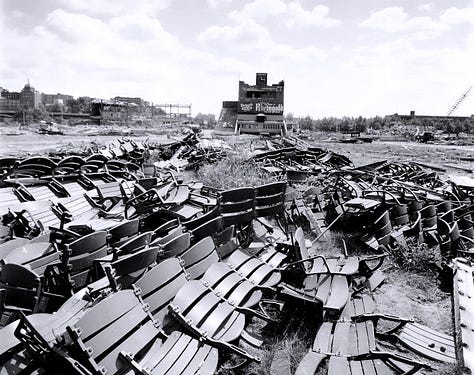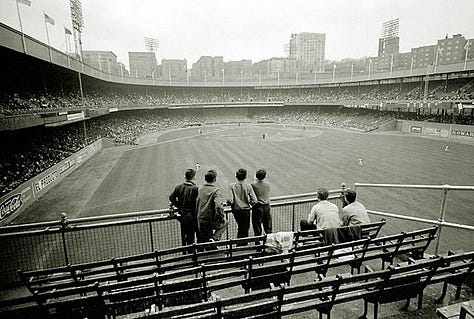Meet the Mets: 1963
Duke Snider hits No. 400, Piersall hits No. 100 and runs the bases backward, Roger Craig losses 18 straight and the Mets play their final season at the Polo Grounds.
The 1963 New York Mets improved on their record from the inaugural season, finishing 51-111. Considering that the Mets recorded the worst single season record in major league history in 1962, the second season was far from a success.
The ‘63 season marked the final year of baseball at the historic Polo Grounds. The Mets drew just over one million fans during the season.
Rookie second baseman Ron Hunt arrived in 1963, playing in 143 games and leading the team in batting average (.272) hits (145) and doubles (28).
Hunt was a blue-collar player and fans loved him. New York Times reporter Arthur Daley described Hunt as a player who … “performs with such a fierce intensity that every ballgame is a holy war with him ...”
"I think they (fans) liked me, because I didn't have a lot of talent, but I gave it all I had. We had blue collar fans. There weren't a lot of suits and ties in the Polo Grounds." - Ron Hunt (The Amazing Mets: 1962-1969)
The 1963 Mets had their fair share of futility too. Roger Craig lost 18 consecutive decisions (May 4-August 8). "It seemed as though every game he pitched, he was in the ballgame. We just didn't have the hitting, the speed or the defense,” said Al Moran
Reporter Gordon White wrote:
To lose 20 games you have to be as good as a pitcher who wins 20 games, otherwise you don't get sent out to the mound every four days. Craig was resigned to his fate. He wanted to win every time he went out, but he wasn't surprised if he didn't win. He was a very intelligent guy and very mature. I think he learned a lot from losing that most people don't get to learn. It's not the end of the world, and you can put it in the proper perspective. He didn't die from losing.
"One of the great things about baseball, and one of the reasons I loved baseball, because I'm an optimistic kind of guy, is that no matter what happens today, there's always a game tomorrow," Jay Hook explained to Bill Ryczek in The Amazing Mets: 1962-1969. “That's kind of a neat thing. It's so different from being in industry. In business, you come back the next day and the problems that you had yesterday, you've still got today. But in baseball, every day is a new start."
Mets icon Ed Kranepool started the 1963 with the Mets. He was just 18 years old. Despite his obvious physical gifts, Kranepool struggled, hitting just .209 in 86 games.
"Eddie (Kranepool) had a great swing and he had great hands. But he didn't have a great body. He didn't run very well, and he was old-looking at 19. I'm not talking about his face, I'm talking about his whole body. He was like a 19-year-old old man." — Bill Denehy
TIMELINE
February 4: New York City mayor Robert F. Wagner signs a bill which formally changes the name of the team’s new ballpark from "Flushing Meadows Stadium" to "William A. Shea Municipal Stadium.”
March 9: Songwriters Ruth Roberts and Bill Katz introduced the official Met theme song, Meet the Mets, to the public. The tune will be modernized in 1984 adding Long Island, New Jersey, Brooklyn, Queens, Uptown and Down, to the team's East side, West side geographical realm.
April 1: Former Brooklyn Dodger Duke Snider returns to New York when the Mets purchase him from LA for $40,000.
April 4: The first reported use of the familiar refrain "Let's Go Mets" is heard at the Polo Grounds in the bottom of the ninth inning during a rout by San Francisco. With the Amazins trailing by 13 runs and down to their last out with no one on base, the rally cry begins..
May 5-10: The Mets win five straight games, beating the Giants, Phillies and the Reds, marking their longest winning streak in the franchise’s short history.
RADIO BROADCAST: MAY 10, 1963
May 23: The Mets traded Gil Hodges to the Washington Senators for Jimmy Piersall.
June 14: Duke Snider hit his 400th career home run against the at Crosley Field in Cincinnati. Snider became the ninth player to reach 400 homers.
June 20: More than 50,000 New York fans pack Yankee Stadium for the first Mayor’s Trophy game between the Mets and Yankees B-team. The Sporting News wrote, The New Breed came out in full force, with banners, bugles, firecrackers and cherry bombs. The Yankees hired 260 extra security guards and ushers. Fans threw firecrackers on the field, leading to more than a dozen were booted from the ballpark, but no arrests were made. After the Mets 6-2 win, more than 5,000 fans overran center field in an effort to pull down the Yankees 1962 World Series banner.
June 23: Jimmy Piersall hit his 100th career HR and proceeded to run the bases backwards. The Mets released Piersall days later. His home run was the only home run he hit for New York.
August 7: Jim Hickman goes 4-for-5 and hits for the cycle, the first in franchise history, as the Mets beat the Cardinals, 7-3, at the Polo Grounds.
August 9: Roger Craig snaps his 18-game losing streak, beating the Chicago Cubs, 7-3, at the Polo Grounds. Craig fired a complete game in the Mets win.
September 11: Al Jackson recorded his 11th win of the season, passing Roger Craig, who won 10 in 1962. Jackson went on to win 13 games, including seven of his last 10 decisions.
September 13: The Giants play their final game at the Polo Grounds. Willie Mays hit a fly ball to center field in his last at bat.
September 18: The Mets play their final game at the Polo Grounds — a 5-1 loss to the Phillies. The attendance: 1,752.
1963 RADIO BROADCASTS
1963 PHOTO GALLERY














